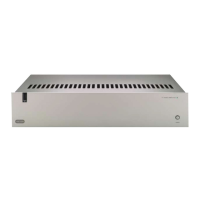Protection circuit block
The P
1 Power amplifier incorporates 4 modes of
protection these are as follows.
o Instantaneous VI current limiting.
o
D.C offset protection.
o Over-Temperature.
o Insulation failure.
The
VI current
limit circuit is built around TR106
and TR119 they sense the voltage across the
0.22-emitter resistors (hence emitter current) and
the collector emitter current or device power
dissipation exceeds a preset limit.
The circuit is designed to allow large unrestricted
currents into loads of 3 ohms and above but limit
the current into a short circuit or very low
impedance loads.
C141, C142 and R162, R163 form a 2.2ms time
constant, which will allow larger transients of
current delivery for a few milliseconds, to ensure
that the amplifier has a sufficiently large transient
capability to drive “difficult” loudspeaker loads.
TR106 senses positive current surges and
TR119 senses negative surges these intern
activate TR107 and switch the optocoupler
OPTO100A this fault notification is sent to the
microcontroller and the output relay is switched
off to protect the amplifier/loudspeaker coils.
The
D.C offset
protection is built around TR108
and TR109 a positive D.C offset will switch
TR108, a negative D.C offset will switch TR120
this will intern switch TR110 and TR109 on in
either case this causes the optocoupler at
location OPTO100B to transmit a fault line signal
to the micro.
The Thermistor RTH100 provides
Thermal
protection
and is connected to the positive
supply rails adjacent to the collector leg of the
output driver at location TR125 this allow the
thermistor to sense the temperature of the output
device. The output impedance of
RTH100 is low when the amplifier is cool
typically a few hundred ohms, in the event of a
thermal overload situation (Above 110 c)
RTH100 will go into a high impedance state
this will switch TR121 on and intern this will
switch TR111 on and cause OPTO 100C to
send a fault line flag to the micro.
The remaining protection stage is an
insulation breakdown detect circuit this is
essentially looking for a breakdown of the
insulating pad between the output devices and
the heatsinks thus +60v path to ground.
The protection is formed around bridge rectifier
package DBR100, this will route current
through the LED in optocoupler OPTO 100D in
the event that the DGND and AGND ground
planes move apart by more than 10v. When
the transistor in the Opto conducts the thyristor
formed by TR112 and TR132 is turned On.
Once the Thyristor conducts it pulls the
SHUTDOWN* signal low and turns TR8 (Sheet
2) off thus opening both Speaker relays and
the Power relay.
Please note
: The unit can only be reset once
the mains power supply to the unit has been
removed and the Amplifiers own power
supplies have been given sufficient time to
discharge +30 secs. The standby transformer
of course remains active.
TR130 asserts the microprocessor fault line
DCPROT so that the micro can indicate the
fault via the front panel mounted LED.
Fig 2 Fault line location and operational status.
Pl
ease note:
Con 4 is the connector between
the main board and the display board, use Pin
2 of Con 4 as a reference (DGND).
Fault line Location Status
D.C offset Con 4 Pin 9 LOW (0v)
V/I Prot Con 4 Pin 8 LOW (0v)
Thermal Con 4 Pin 7 LOW (0v)

